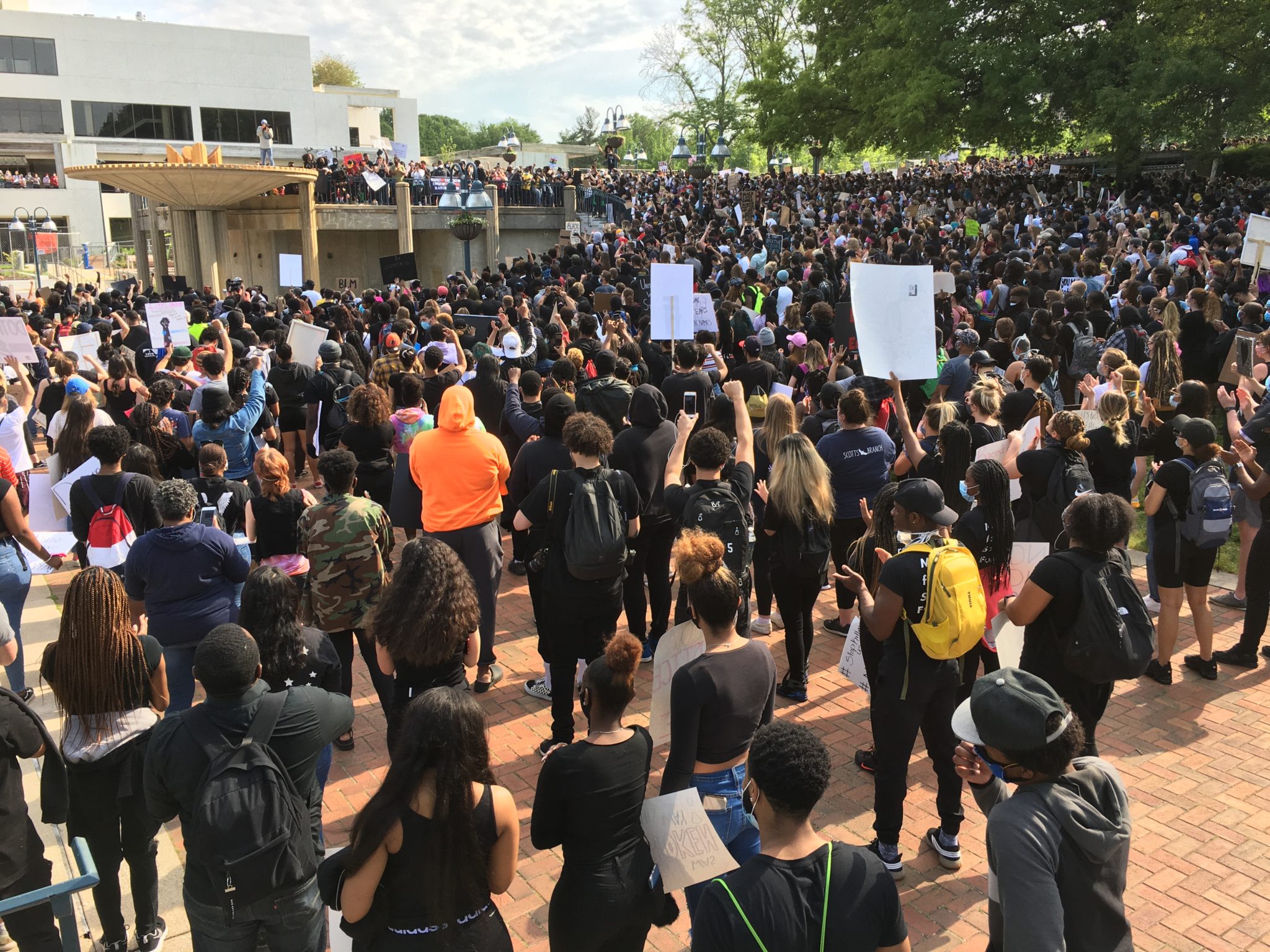Inspirational: Blacks and Whites Protesting Together Against Racial Injustice
Protest for racial justice in Columbia, Maryland. (MarylandReporter.com photo by Len Lazarick)
BALTIMORE – At the end of this miserable week, with virus in the air and protesters in the streets and the president in his bunker hollering for U.S. troops to “dominate” their fellow citizens, there comes a telephone call from Al Rawlings.
The call reaches across the American racial divide. It reaches across 60 years. That’s how long we know each other, from high school days at Baltimore City College, in a bygone era just before Americans first started taking to the streets to protest overt and systemic racism.
Rawlings grew up in South Baltimore’s Cherry Hill neighborhood and never saw a white face in a classroom until he got to high school. He took two buses and a streetcar to reach City. He ran varsity cross-country and track there, at championship level. Also, he was in D4, one of the smart homerooms.
He was college material, but wound up in the army. Stationed in North Carolina, he trained to become a green beret. Once, they sent Al and half a dozen other guys into the woods for two weeks. For subsistence, they were given two live chickens, a bag of potatoes and a bag of onions. Plus whatever they could catch and kill. He had a fear of heights but did scores of parachute jumps.
After three years in the army, he came back to Baltimore and went to work for General Motors. He worked there for decades. Also, in the late ‘60s, he joined the Baltimore branch of the Black Panthers.
“People thought we were out to take over the country,” he said the other night.
I remembered covering the Panthers back then. In Baltimore, the Panthers’ biggest effort was a free breakfast campaign for all these poor kids who otherwise would have gone to school with empty stomachs.
“Exactly right,” Rawlings said. “But you had all these people who thought we were out for violence.”
He meant white people, but didn’t have to say so. It was part of the racial divide, the inability to see each other’s humanity, which is playing itself out now, as this president talks of bringing out the military to confront their fellow Americans.
“Unimaginable,” Rawlings said.
But some other things are also unimaginable, good and bad.
Those people out there now, protesting the killing of George Floyd – they’re inspiring, because they reflect the American racial mix. Black people aren’t alone in this fight, and this is obvious both in the crowds all over the country and in the polls, where a majority of whites support the protesters and deplore the murderous police tactics.
This is a major difference from the era Rawlings and I knew. African-Americans were marching for the right to vote, for equal citizenship. Or they were raging against the killing of Dr. Martin Luther King.
But they were doing it mostly on their own. And they were so consumed by it that the other great demonstrations of the era – against the war in Vietnam – was almost entirely white people.
But here’s another difference. In our little era, when Rawlings and I were young, the demonstrations weren’t very integrated – but the public schools were.
It was that brief period, between the 1954 U.S. Supreme Court decision integrating the schools and, roughly 15 years later, when most of the white students had gone elsewhere and the public schools were becoming re-segregated.
“Never had a white person in any school until I got to City College,” Rawlings said. “Walked in the first day, nervous as hell. Felt like everybody was watching me.”
They weren’t. In our (all-male) class, there were roughly 750 boys. About one-third were black. Rawlings ran cross-country and track for a coach named Jerry Nathanson, who made certain everyone knew his philosophy of life because he announced it pretty often.
“The hell with color and religion,” he’d say. “You’re either a man, or you’re not.”
That’s a lesson that should echo across these crowded streets today. And across our public schools.
But the classrooms in this city are different now. In the 15 years after the Supreme Court okayed integration, there were racial percentages that reflected Baltimore’s overall population of that time – roughly 60 percent majority white.
Back then, there were 160,000 students in the city’s public schools. Today, 80,000. The decline is partly understandable. Back then, the city had nearly a million people. Now, barely 600,000. And the white exodus that started in the post-war years has continued – and many of the white families still living in the city send their children to private or parochial schools.
Baltimore’s public schools are now just over 7 percent white, 77 percent black, 13 percent Latino. And Baltimore City College? It’s 14 percent white.
When we talked the other night, Rawlings and I agreed on this: the school integration of our era was a gift to us. It felt like a reflection of the American ideal. And it taught us to look at people of different backgrounds as individuals, not as a collection of stereotypes.
These kids in schools today, which have become re-segregated – it’s their loss.
That’s why it’s inspiring to see those demonstrating in the streets over George Floyd. They’re the American mix.
They’re saying what our better angels have been saying for years: America wasn’t created to “dominate” one another, but to learn from each other, and to find each other’s better selves, whatever we happen to look like.

Michael Olesker, columnist for the News American, Baltimore Sun, and Baltimore Examiner has spent a quarter of a century writing about the city he loves.He is the author of several books, including Michael Olesker’s Baltimore: If You Live Here, You’re Home, Journeys to the Heart of Baltimore, and The Colts’ Baltimore: A City and Its Love Affair in the 1950s, all published by Johns Hopkins Press.

